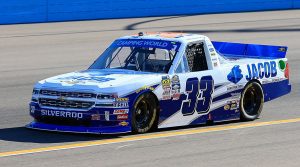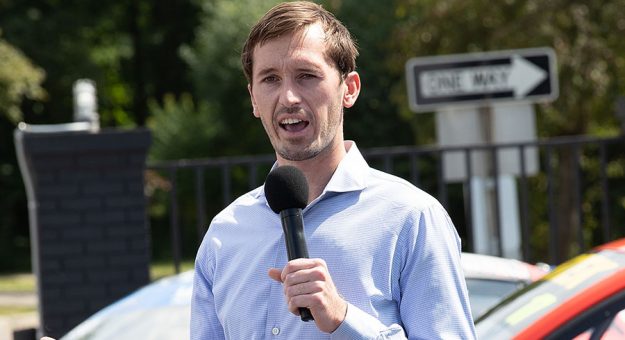When Kennedy was a racer, there was little he enjoyed more than showing up at the race track on a Friday and getting back on track. He also enjoyed the energy and adrenaline that came from behind the wheel of a stock car and the comradery he experienced with his team.
NASCAR has a lot of moving parts that have to move in unison to make the show successful. It takes more than opening the garage, unloading the cars and waving the green flag to be successful.
It’s also about building relationships, whether it is driver to crew chief, or team owner to NASCAR.
Kennedy understands that each of those qualities have to be in synch. That is often the challenge.
He also has a deep reverence for the sport’s history.
“It’s amazing to see where we have evolved to, up to the early 2000s and then where we have advanced from 2000 to today,” Kennedy explained. “The technology has improved exponentially further, especially the past two decades.
“What is exciting about the Next Gen car is we get to take a lot of the technology we learned from the safety side of it and add additional layers on top of that from connectivity to the car and all the data from additional in-car cameras and what we will learn from that,” Kennedy added. “It’s amazing to see the evolution of that, where we have come from and where we have gotten to today.”
Bill France Jr. died in 2007, but Kennedy still learned a great deal from his grandfather.
“He was very results-driven and incredibly well-respected in the garage area, incredibly liked as well,” Kennedy said. “He was an incredibly hard worker. My great-grandfather started the sport and got it going, but my grandfather got it going nationwide and turned it into a national sport with the television contract to televise the first Daytona 500 live, flag to flag in 1979.
“I didn’t have any experiences with him in the board room,” Kennedy noted. “I’m sure he was stern at times and I’ve heard certain stories, but he was incredibly well-liked and well-respected in the garage area and throughout the industry.”
While Bill France Jr. was front and center throughout his career, much of Jim France’s work was behind the scenes.
“Jim and my grandfather were similar, but also different,” Kennedy said. “Bill led the day-to-day decisions and Jim was involved in that, too. Jim is very engaged in it now and also has a lot of trust in his management team with Steve Phelps and Steve O’Donnell and the entire group. He has established a great group around him.”
Phelps, O’Donnell and Mike Helton are key advisers to Kennedy because of the practical experience they have had.
“You can learn a ton from them,” Kennedy admitted. “Jim and Mike have been around the sport their entire lives. Steve O’Donnell is always there for competition questions. Steve Phelps has such a broad perspective on every type of interest. He also has a lot of well-rounded knowledge outside of this sport too, like what other sports leagues are doing that we should be doing, too.
“That’s very helpful as well.”
Of course, there is Kennedy’s mother, Lesa, who is always there to share her knowledge with her son.
“Anything track related, real estate related, consumer admissions related, she knows it well and is super helpful in those areas,” Kennedy said.
Kennedy is prepared to lead NASCAR into the future.
“Ben’s well-respected leadership brings a renewed perspective to our team,” said Steve Phelps, NASCAR President. “He is willing to take chances and make bold moves, all with a deep understanding of and respect for NASCAR’s roots. He has added a lot of enthusiasm, and his leadership is a major reason for our growth over the last few years.”
Kennedy’s list of initiatives is impressive. Those include the bold and innovative changes to the schedule as well as bringing the Busch Light Clash to the famed Los Angeles Memorial Coliseum.

“That idea really came to fruition in 2019 as we were looking for new markets and new locations where we could race for our 2021 scheduling initiative,” Kennedy recalled. “We went to a couple different locations and looked at where we could race whether it be a stadium, short track, street course or an intermediate. What options are out there? How do we go to some of these markets and build a temporary short track?
“We went to Los Angeles and the size of that market, we thought it was important for us to find something in that downtown area. We were driving past the Coliseum one day. It was a moon-shot goal, but we asked, ‘How cool would that be if we could figure out and develop a temporary track inside the Coliseum itself?’”
After a few conversations, it became a reality.
The Next Gen car from an on-track product and team business model perspective will change the way NASCAR operates.
Further into the future, Kennedy believes international expansion is a big opportunity. There are currently nine or 10 different countries with a NASCAR-sanctioned series. He would like to bring the sport to some of the larger cities around the world.
“There is a lot to think about and a lot of really smart people that are on it,” Kennedy said. “It’s neat to just be a part of it.”
NASCAR is literally in Kennedy’s DNA and one day, he’ll probably be the next France family member who is the face of NASCAR as its leader.
